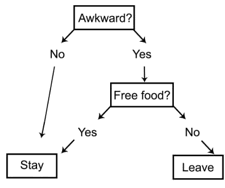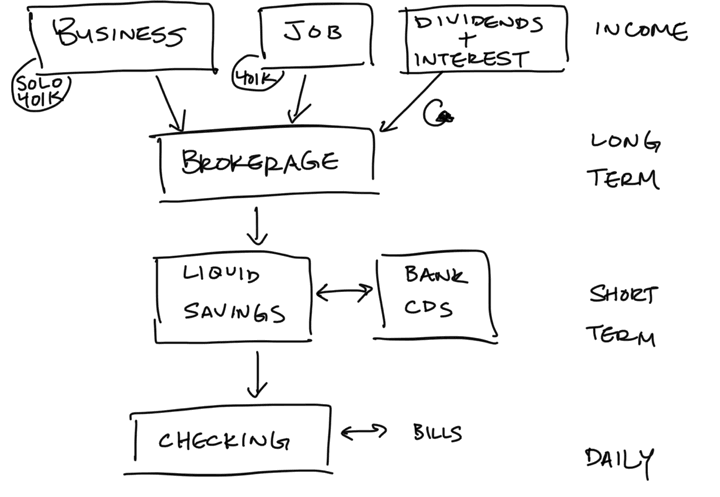 A reader asked me to complete a money map to help visualize how I manage our finances, as per this neat Money Map chain. I wasn’t sure exactly how much detail to add, but the flowchart below is a good representation of how I organize things mentally. Specifics like brokerage or bank choices may change a few years from now, but this overall structure probably won’t.
A reader asked me to complete a money map to help visualize how I manage our finances, as per this neat Money Map chain. I wasn’t sure exactly how much detail to add, but the flowchart below is a good representation of how I organize things mentally. Specifics like brokerage or bank choices may change a few years from now, but this overall structure probably won’t.

Income sources. We receive income via business profits, W-2/contractor jobs, and our portfolio. A portion is automatically directly into 401k, HCFSA, DCFSA, and Solo 401k accounts. (We are not eligible for an HSA.) The dividend and interest income is a circular arrow because technically it is generated and then held in the brokerage account. One day, this might include Social Security, rental income, annuity payments, etc.
Long-term investments (5+ years time horizon). Historically, all our income flows directly into our brokerage accounts (most brokers allow direct deposits). I used to invest monthly, but now the business/job income flows are much smaller in semi-retirement. Dividends arrive into the taxable account quarterly, so I now check once every three months to manually reinvest and/or distribute funds as needed. Other than this check-in every 3 months, this tier is “consciously neglected” and designed to grow over time and eventually become self-sustaining. Here are my intermittent portfolio updates.
Short-term investments (1 month to 5 years). This tier is basically my “emergency fund”. In the accumulation stage, it was between 6 months to a year of expenses. Now, I keep five years of expenses as I am much more reliant on unstable portfolio income and there is less stable job income (human capital). Money comes in quarterly from above, and is taken out monthly for household expenses. This tier is “actively-managed” as I aim for higher returns without extra risk to principal (everything is US gov’t/FDIC/NCUA-insured).
- Liquid savings. Roughly one year of expenses are kept in a 100% liquid savings account. The location can vary but the default is Ally Bank, as they have a good balance of decent rates, solid user interface for interbank transfers, and human customer service. You can also create multiple savings accounts, all with no minimum balance.
- Certificates of deposit, etc. The other 4 years of expenses are moved roughly into a 5-year CD ladder, adjusted based on rates. Savings bonds and Treasury Bills may also be used if priced competitively. I tried to take advantage of CD rates when they were 3.5 to 4% APY. I write about these banking opportunities regularly and summarize them monthly.
- Bank bonuses. If CDs rates are not worthwhile, cash may also be optimized via banking promotions. Banks offer you an incentive to try their product, and I accept the offer if the terms are agreeable. I also write about these opportunities here as they come up.
Day-to-day needs. Each month, a “paycheck” transfer goes from savings to checking. Wherever possible, our day-to-day expenses are put on credit cards to trigger the best credit card bonuses. After the float period, it is paid off in full from checking. A larger purchase may require a direct withdrawal from savings account (i.e. estimated tax payments) or one-time transfer to checking (i.e. fix the fridge). I also use Ally Checking, as you can assign one of your savings accounts as a no-fee overdraft backup source.
This design includes a few purposeful features.
- Savings to 401k are automatic and first, which is critical when that is your major source of savings. It should happen without any energy requirement. No effort, no reminders.
- Work income is separated from our spending. In the accumulation stage, you want to get bigger paychecks over time but try your best to ignore them when it comes to spending. Instead, all the income gets mixed together and the first place it lands is long-term investments. In semi-retirement, our incomes fluctuate (quite downward in 2020) and we smooth things out with portfolio withdrawals.
- Portfolio fluctuations are also tempered by a big cash bucket. It’s easier to sleep at night when you have five years of expenses in safe cash readily available. We didn’t need this much cash in the accumulation stage, but when you rely on the stock market for part of your monthly income, it really helps. Is it psychological? Yes.
- The “fun” hobby stuff is optional. Don’t feel like chasing rates? Just consolidate at one bank. Don’t feel like a different credit card every quarter? Just switch to one.
- All accounts are joint where possible. That is simply what has worked best for us.
Anyhow, that’s how it works for us. That monthly transfer from savings to checking gives me a rough idea of our monthly and thus annual spending. As long as that number stays a reasonable percentage of our total portfolio, things are happy. We have had a lot of luck, and I don’t want to squander it.
 The Best Credit Card Bonus Offers – 2025
The Best Credit Card Bonus Offers – 2025 Big List of Free Stocks from Brokerage Apps
Big List of Free Stocks from Brokerage Apps Best Interest Rates on Cash - 2025
Best Interest Rates on Cash - 2025 Free Credit Scores x 3 + Free Credit Monitoring
Free Credit Scores x 3 + Free Credit Monitoring Best No Fee 0% APR Balance Transfer Offers
Best No Fee 0% APR Balance Transfer Offers Little-Known Cellular Data Plans That Can Save Big Money
Little-Known Cellular Data Plans That Can Save Big Money How To Haggle Your Cable or Direct TV Bill
How To Haggle Your Cable or Direct TV Bill Big List of Free Consumer Data Reports (Credit, Rent, Work)
Big List of Free Consumer Data Reports (Credit, Rent, Work)
Thanks for sharing – this is very different (and opposite) of how I currently save (as a growing household) as well as how I saved pre-family. This is a fun structure and would be interesting to see this perhaps shared as a ‘guest’ feature
Thanks, that is a good idea.
I love the map in the top right corner. As an introvert, I very much relate. Last Thanksgiving my wife and I were invited to what we thought would be a dinner with a small group of friends – only to find it was a mob scene with all kinds of extended family. But everyone brought something to eat, so that was at least some compensation for the awkwardness I felt.
Ha, I was looking for a small but funny flowchart and that was the best one. For me, it reminded me of college, as every student group meeting had free pizza and that was the tipping point justification to go to the meeting. It provided me (a cheap introvert) a reason to be social!